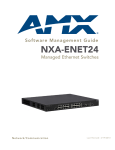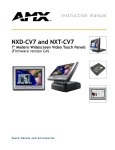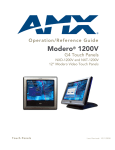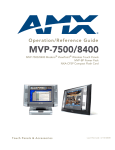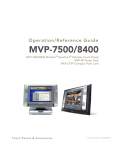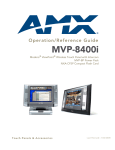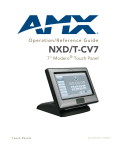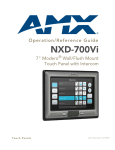Download AMX MAX-AVM Installation guide
Transcript
Installation Guide NXA-ENET24 PoE Fast Ethernet Switch For more detailed installation, configuration, programming, and operating instructions, refer to the NXA-ENET24 Hardware Installation and Software Management Guides available on-line at www.amx.com. Overview The NXA-ENET24 PoE Fast Ethernet switch is specifically designed to protect the video streams coming from AMX’s MAX units to the Audio Video Modules (AVM). Standard switches will reduce bandwidth from all applications when there is heavy data traffic passing through the switch. For streaming audio and video applications this will cause skipping and jitter in the audio and video feeds. This is unacceptable for AMX’s applications. As a result, AMX has designed the NXA-ENET24 PoE to protect the A/V streams when heavy data traffic occurs. Bandwidth is reduced from other applications such as file transfer, e-mail and web surfing only when heavy data traffic events occur. The NXA-ENET24 PoE also provides a full range of features for Layer 2 switching. It includes a management agent that allows you to configure the features listed in the products manual. The default configuration can be used for most of the features provided by this switch. However, there are many options that you could configure to maximize the switch’s performance for your particular network environment. The NXA-ENET24 PoE’s 24 10/100 Mbps ports support the IEEE 802.3af Power-overEthernet (PoE) that enables DC power to be supplied to attached devices over the unused pairs of wires in the connecting Ethernet cable. Description of Hardware Port Status LEDs (Cont.) 1~24 (PoE Mode) 1000BASE-T/SFP Ports These are combination Gigabit RJ-45 ports with alternate Small Form Factor Pluggable (SFP) transceiver slots. If an SFP transceiver (purchased separately) is installed in a slot and has a valid link on the port, the associated RJ-45 port is disabled. The 1000BASE-T RJ-45 ports support automatic MDI/MDI-X operation, so you can use straight-through cables for all network connections to PCs or servers, or to other switches or hubs. The 1000BASE-T RJ-45 ports do not support PoE capability. Port and System Status LEDs The LEDs, which are located on the front panel for easy viewing, are described in the following tables. The port status LEDs have two display modes; Link and PoE. The Link mode displays the link status and network activity on each port. The PoE mode displays the PoE power status on each port. Use the Mode Link/PoE button on the front panel to toggle between the two display modes. The current mode is indicated by the Link/Act and PoE system LEDs. Flashing Green Powered device is receiving power. Flashing Amber Port has detected a power overload or short circuit and shut down the port’s power. On Amber The power budget for the switch has been exceeded and the port's power shut down. Alternate Green/ Amber Port has been disabled by the administrator. Off No powered device is connected to the port. LED Condition Status PWR On Green Unit’s internal power supply is operating normally. Off Unit has no power connected. On Green System diagnostic test successfully completed. Diag Stacking 10/100BASE-T Ports The switch base unit contains 24 10BASE-T/100BASE-TX RJ-45 ports. All ports support automatic MDI/MDI-X operation, so you can use straight-through cables for all network connections to PCs or servers, or to other switches or hubs. Each of these ports support auto-negotiation, so the optimum transmission mode (half or full duplex), and data rate (10 or 100 Mbps) can be selected automatically. If a device connected to one of these ports does not support auto-negotiation, the communication mode of that port can be configured manually. Each port also supports IEEE 802.3x auto-negotiation of flow control, so the switch can automatically prevent port buffers from becoming saturated. Powered device is connected, but not drawing power. System Status LEDs The NXA-ENET24 PoE Fast Ethernet switch measures 17.32 x 16.14 x 1.69 inches (44.0 x 41.0 x 4.3 cm). (See FIG. 1) FIG. 1 The NXA-ENET24 PoE Fast Ethernet switch On Green Flashing Green System diagnostic test is in progress. On Amber System diagnostic test has detected a fault. Flashing Amber Cannot receive packet from stacking port. Alternate Green/ Amber Fan has failed or the unit has over-heated. On Green This switch is acting as the master unit in the stack. Flashing Green Initial state of stacking configuration to determine whether the switch will act as a master or slave unit. On Amber This switch is acting as a slave unit in the stack. Link/Act On Green LED display mode is Link/Act. PoE On Green LED display mode is PoE. Combination Ports 25-26 (Link/ Activity) On/Flashing Amber Port has established a valid 10/100 Mbps network connection. Flashing indicates activity. On/Flashing Green Port has established a valid 1000 Mbps network connection. Flashing indicates activity. Off There is no valid link on the port. Stack Master Button The Stack Master button enables one switch in the stack to be selected as the master. Seven other switches can be stacked together and they should be placed in "Slave" mode. When operating in a stand-alone configuration the switch should be in "Master" mode. Mode PoE/Link Button The Mode PoE/Link button is located on the front panel. The Mode PoE/Link button is used to toggle between the two port status LED display modes. Pressing this button changes from one display mode to the other. The default display mode is Link/Act mode. Power Supply Receptacle Port Status LEDs LED Condition Status 1~24 (Link/Act Mode) On/Flashing Green Port has established a valid 100 Mbps network connection. Flashing indicates activity. On/Flashing Amber Port has established a valid 10 Mbps network connection. Flashing indicates activity. Alternate Green/ Amber Port has been disabled by the administrator. Off There is no valid link on the port. The standard power receptacle is for the AC power cord. It is located on the rear panel of the switch. MAX A/V Network The switch is an excellent choice for mixed AMX equipment such as PoE enabled NXA-WAP 200 G wireless access points, and non-PoE devices such as AVMs, Breakout Boxes and MAX. You can easily build on this basic configuration, adding direct full-duplex connections to AVMs, Breakout Boxes and WAPs. When the time comes for further expansion, just connect to another hub or switch via one of the switch’s Fast Ethernet or Gigabit Ethernet ports. The switch automatically identifies the devices requirements, i.e., power for the WAP200G and network priority for MAX streams to the AVMs so no configuration is required by the installer. Connecting to a Power Source Ports Port Number 1 - 24 Description Ports 1 - 24 can be used to connect AMX’s Master, AVMs, Breakout Boxes, WAP 200 Gs and/or other Ethernet based devices requiring 10 or 100 Mbps data throughput. In addition, ports 1 - 24 support PoE with automatic power detection. • If the connected device does not support PoE the switch will not turn "On" power to that port. 25 This port provides 10/100/1000 Mbps data throughput and can be used to support MAX units or stacking other switches together. The PoE is not supported on this port. 26 This port provides 10/100/1000 Mbps data throughput and can be used to support MAX units, or connections to the LAN/Internet. The PoE is not supported on this port. To connect a switch to a power source: 1. Insert the power cable plug directly into the AC receptacle located at the back of the switch. 2. Plug the other end of the cable into a grounded, 3-pin socket, AC power source. Note: For international use, you may need to change the AC line cord. You must use a line cord set that has been approved for the receptacle type in your country. 3. Check the front-panel LEDs as the device is powered on to be sure the PWR LED is lit. If not, check that the power cable is correctly plugged in. Connecting Network Devices The PoE switch is designed to be connected to 10 or 100 Mbps network cards in PCs and servers, as well as to other switches and hubs. If 802.3af-compliant PoE devices are connected to the switch’s 10/100 Mbps ports, the switch automatically supplies the required power. Twisted-Pair Devices Application Notes 1. Full-duplex operation only applies to point-to-point access (such as when a switch is attached to a workstation, server or another switch). When the switch is connected to a hub, both devices must operate in half-duplex mode. 2. Avoid using flow control on a port connected to a hub unless it is actually required to solve a problem. Otherwise back pressure jamming signals may degrade overall performance for the segment attached to the hub. 3. As a general rule the length of fiber optic cable for a single switched link should not exceed: • 1000BASE-SX: 550 m (1805 ft) using multimode fiber • 1000BASE-LX: 5 km (3.2 miles) using single-mode fiber • 100BASE-LH: 70 km (43.5 miles) using single-mode fiber However, power budget constraints must also be considered when calculating the maximum cable length for your specific environment. Installing the Switch Selecting a Site Switch units can be mounted in a standard 19-inch equipment rack or on a flat surface. Be sure to follow the guidelines below when choosing a location. The site should: • be at the center of all the devices you want to link and near a power outlet. • be able to maintain its temperature within 0 to 50 °C (32 to 122 °F), and its humidity within 5% to 95%, non-condensing • provide adequate space (approximately two inches) on all sides for proper air flow • be accessible for installing, cabling, and maintaining the devices • allow the status LEDs to be clearly visible Make sure that twisted-pair cable is always routed away from power lines, fluorescent lighting fixtures and other sources of electrical interference, such as radios and transmitters. Make sure that the unit is connected to a separate grounded power outlet that: • provides 100 to 240 VAC, 50 to 60 Hz • is within 2.44 m (8 feet) of each device • is powered from an independent circuit breaker As with any equipment, using a filter or surge suppressor is recommended. Ethernet Cabling To ensure proper operation when installing the switch into a network, make sure that the current cables are suitable for 10 Base-T, 100Base-TX or 1000 Base-T operation. Check the following criteria against the current installation of your network: • Cable type: Unshielded twisted pair (UTP) or shielded twisted pair (STP) cables with RJ-45 connectors; Category 3 or better for 10BASE-T and Category 5 or better for 100BASE-TX and 1000 Base-T. • Protection from radio frequency interference emissions • Electrical surge suppression • Separation of electrical wires (switch related or other) and electromagnetic fields from data based network wiring • Safe connections with no damaged cables, connectors or shields Each device requires an unshielded twisted-pair (UTP) cable with RJ-45 connectors at both ends. Use Category 5, 5e or 6 cable for 1000BASE-T connections, Category 5 or better for 100BASE-TX connections, and Category 3 or better for 10BASE-T connections. Power-over-Ethernet Connections The PoE switch automatically detects an 802.3af-compliant device by its authenticated PoE signature and senses its required load before turning on DC power to the port. This detection mechanism prevents damage to other network equipment that is not 802.3af complaint. Note: Power-over-Ethernet connections work with all existing Category 3, 4, 5, 5e or 6 network cabling, including patch cables and patch-panels, outlets, and other connecting hardware, without requiring modification. The switch delivers power to a device using the two unused wire pairs in UTP or STP cable (RJ-45 pins 4, 5, 7, and 8). The switch can provide up to 15.4 W of power continuously on each 10/100 Mbps port. However, taking into account some power loss over the cable run, the amount of power that can be delivered to a terminal device is 12.95 W. If a device draws more than 15.4 W, from a port, an overload condition occurs and the port turns off the power. The switch controls the power and data on a port independently. Power can be requested from a device that already has a data link to the switch. Also, the switch can supply power to a device even if the port’s data connection has been disabled. The power on a port is continuously monitored by the switch and it will be turned off as soon as a device connection is removed. Cabling Guidelines The RJ-45 ports on the switch support automatic MDI/MDI-X pinout configuration, so you can use standard straight-through twisted-pair cables to connect to any other network device (PCs, servers, switches, routers, or hubs). Caution: Do not plug a normal phone jack connector into an RJ-45 port. This will damage the switch. Use only twisted-pair cables with RJ-45 connectors that conform to FCC standards. Connecting to MAX, AVM, WAPs, Breakout Boxes, Servers, Hubs and Switches 1. Attach one end of a twisted-pair cable segment to the device’s RJ-45 connector. 2. If the device is a network card and the switch is in the wiring closet, attach the other end of the cable segment to a modular wall outlet that is connected to the wiring closet. (See “Network Wiring Connections” on page 25.) Otherwise, attach the other end to an available port on the switch. • Make sure each twisted pair cable does not exceed 100 meters (328 ft) in length. Note: Avoid using flow control on a port connected to a hub unless it is actually required to solve a problem. Otherwise back pressure jamming signals may degrade overall performance for the segment attached to the hub. 3. As each connection is made, the green Link LED (on the switch) corresponding to each port will light to indicate that the connection is valid. Mounting This switch can be mounted in a standard 19-inch equipment rack or on a desktop or shelf. Mounting instructions for each type of site follow. Consult the NXA-ENET24 Hardware Installation Guide, Installing The Switch for information on installing the switch into a rack. Desktop or Shelf Mounting 1. 2. 3. 4. Attach the four adhesive feet to the bottom of the first switch. Set the device on a flat surface near an AC power source, making sure there are at least two inches of space on all sides for proper air flow. If installing a single switch only, go to “Connecting to a Power Source” at the end of this chapter. If installing multiple switches, attach four adhesive feet to each one. Place each device squarely on top of the one below, in any order. For full warranty information, refer to the AMX Instruction Manual(s) associated with your Product(s). 11/06 ©2006 AMX. All rights reserved. AMX and the AMX logo are registered trademarks of AMX. AMX reserves the right to alter specifications without notice at any time. 3000 RESEARCH DRIVE, RICHARDSON, TX 75082 • 800.222.0193 • fax 469.624.7153 • technical support 800.932.6993 • www.amx.com 93-2178-61 REV: A


